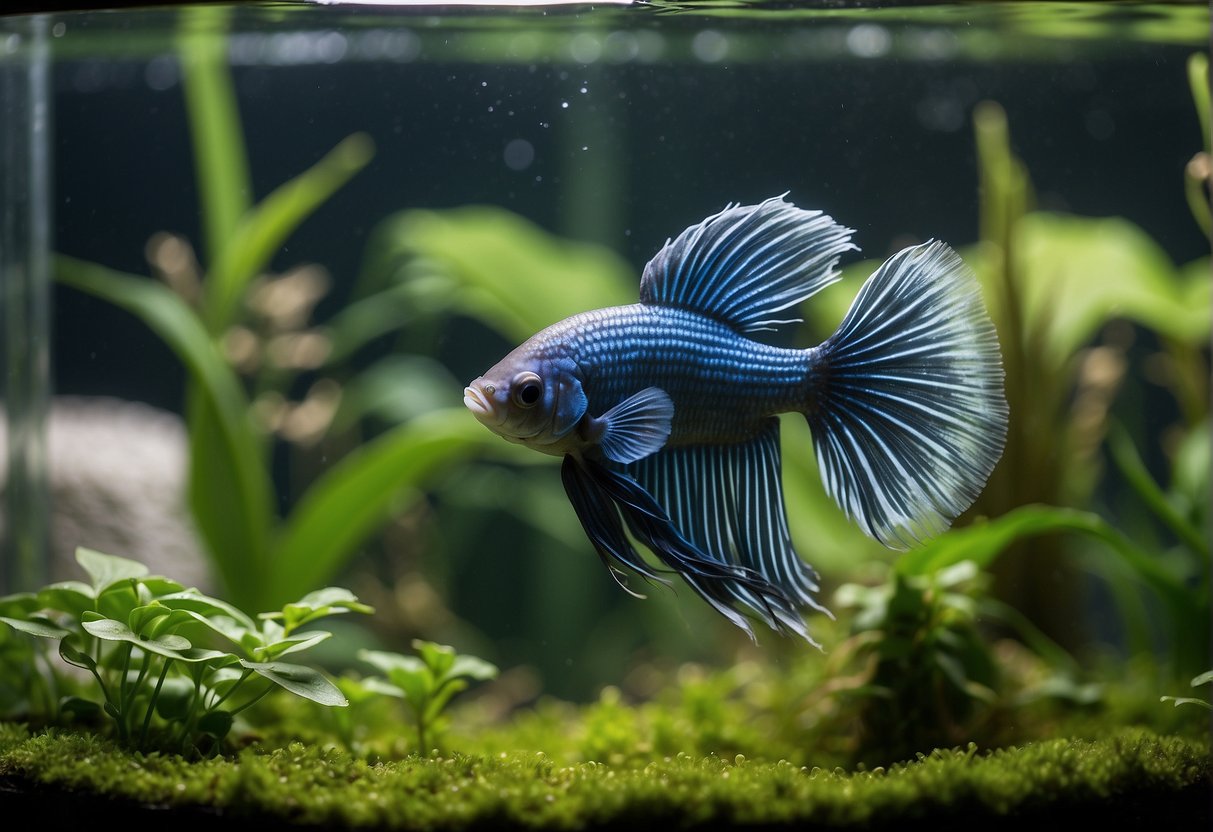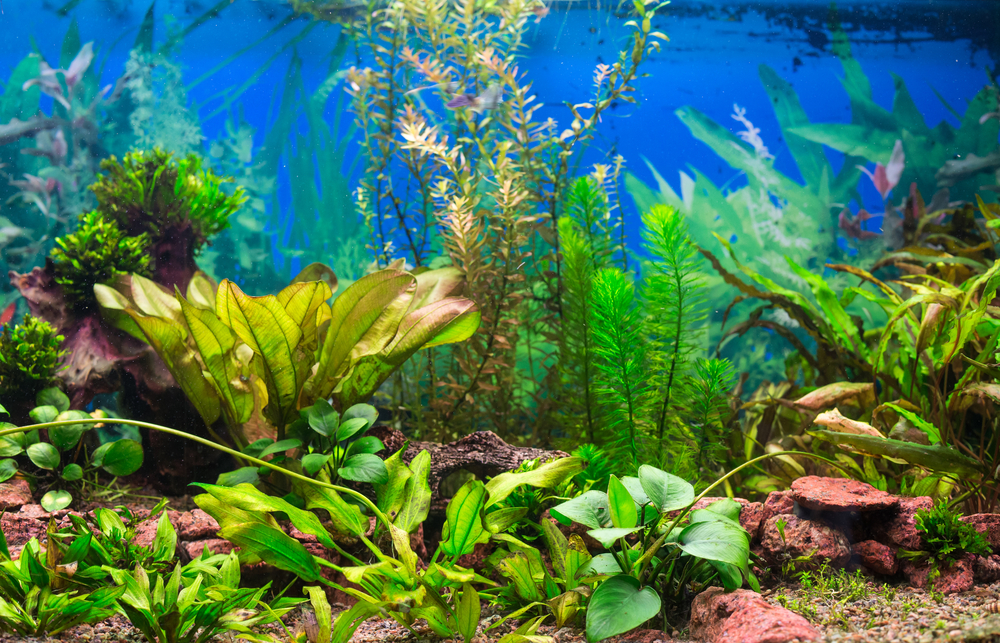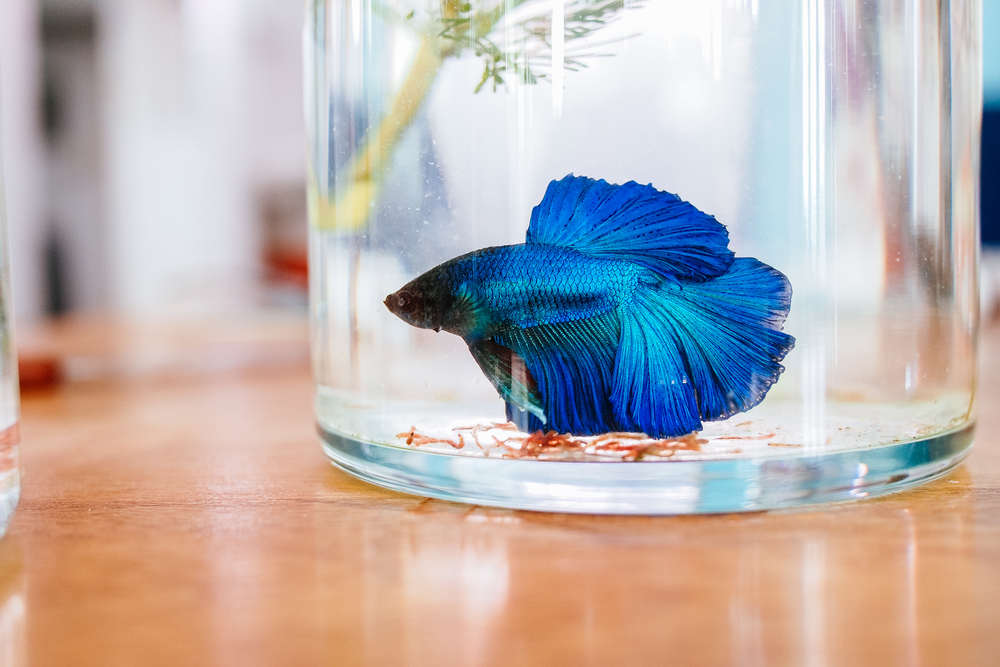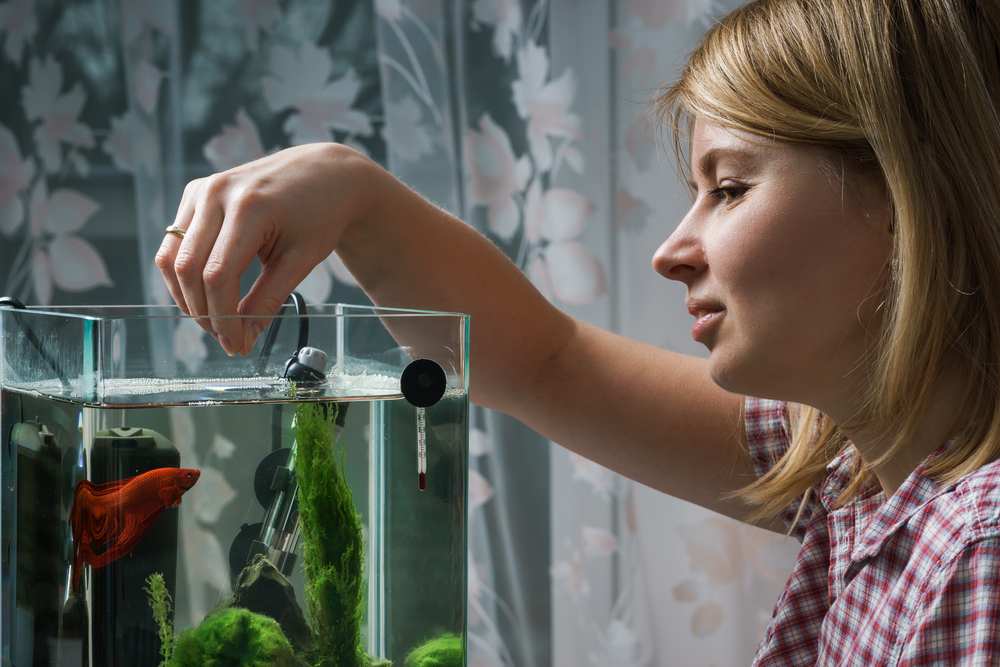With their vibrant colors, magnificent fins, and playful tendencies, betta fish are truly breathtaking aquarium pets. They are fun to watch and very rewarding to keep—except when miserable. And when these little creatures are unhappy, it’s hard to miss, as they are no longer as vibrant or playful as before.

Your betta can be unhappy for many reasons, ranging from illness and starvation to pesky tank mates or an uncomfortable aquarium—all elements within your control. So, if you want to keep your little pet friend happy and flourishing, your work is cut out for you. But do not worry; you have some help.
Read the rest of this comprehensive guide to find all you need to know on how to keep a betta fish happy. Know how to properly take care of you betta friend from these other top picks:
- How to Feed Snail in Betta Tank
- How to Keep Betta Fish Warm Without a Heater
- How to Transfer Betta Fish from Cup to Tank
Contents
Setting Up the Perfect Habitat
Do you want your betta fish to be happy and stay that way? Then, the first thing to concern yourself with is the quality of their living arrangements. You need to ensure their habitat is comfortable and safe, and the relevant considerations here include everything from tank size and water quality to lighting, filtration, and even tankmates.
1. Choosing the Right Tank
Getting the right tank size is essential because it’s one of the primary factors determining how comfortable your betta is. Too small a tank, and things can get very claustrophobic for your fish; too big a tank—you know, there is probably no such thing anyway. You can never really have too much space for your betta fish.
That said, the ideal tank volume for a single betta is at least 5 gallons. This is enough to provide ample swimming space and maintain stable water conditions without taking up too much house space.
2. Water Quality and Parameters

With an adequately sized tank in order, the next concern is the water quality and parameters. These parameters are the most important because just as bad air can harm you, the wrong water conditions can also harm your betta.
The first vital water parameter is the pH level, which indicates how acidic or basic the water is. The ideal range is between 6.5 to 7.5, from slightly acidic to slightly basic.
Next, you must control the nitrite and nitrate levels, maintaining the former at 0 ppm and the latter at less than 20 ppm. Finally, mind the temperature. Betta fish require warm water, ideally between 76 and 81 degrees Fahrenheit.
You must keep some water test kits handy to maintain all these conditions. You should also change the water periodically and regularly, replacing at least 20 – 25% with clean water weekly. Distilled water is generally best, but you can use tap water if you neutralize all harmful chlorine content using a water conditioner.
3. Aquarium Decor and Plants

At first, it may seem that interior decor for your betta tank is just an aesthetic matter. However, it does impact the well-being of the tank’s occupants.
Betta fish are famously playful and curious organisms that enjoy swimming about now and then, exploring every corner of the tank. They also tend to hide quite a bit and need materials to build bubble nests when it’s spawning time.
So, it’s imperative to include decorations and plants in your aquarium since these serve as hiding and playing spots and are also useful materials for bubble nests.
When choosing plants, you want to go for live and silk ones. They are safer than plastic alternatives and instrumental in maintaining water quality by absorbing nitrates. Rocks and pebbles for hiding spots should ideally be smooth-edged to prevent injuring the betta.
4. Lighting and Filtration
Betta fish don’t do too well with poor lighting, especially lighting that lets them see their reflection in the tank glass. They will perceive the reflection as another male challenger and get aggressive. So, regarding lighting, you need a moderate setup that mimics natural daylight cycles, reduces reflections, and enables live plants to grow.
Filtration is also important. You need to equip your tank with a gentle filter that doesn’t create strong currents. Bettas prefer calm waters.
5. Tank Acclimation

Once your tank is set up, you need to acclimate your betta to it, which can be tricky. It’s crucial to ensure that you acclimate them slowly because doing it too fast may cause physical harm and mental distress. S
o, practice proper acclimation by gradually introducing tank water into the container that your betta came in for over an hour. When done, you can then gently release them into the tank.
6. Maintaining a Clean Environment
Over time, your betta tank will accumulate debris, harmful bacteria, and other things that make it less sanitary. Changing the water regularly helps keep things clean, but you need to do more.
For example, regular maintenance should be conducted, including weekly water changes and checking filter cartridges. You should also monitor bacterial levels and tank cleanliness without overcleaning and disturbing beneficial bacteria. This is beneficial because some bacteria help clean the tank by breaking down debris and fish waste.
7. Co-Inhabitants Considerations

Tankmates are among the biggest sources of potential disturbance for your betta fish. Not all marine organisms will get along with your betta, so if you want it to have tankmates, you need to be careful with the selection.
You might go for peaceful species like neon tetras or cory catfish, which do not compete with bettas for territory. If you don’t want another fish as the tankmate, you can also try marine snail species like Turret or Malaysian snails, provided your tank has an excellent substrate.
Still, always observe your betta’s response to new tank mates, as some prefer solitude altogether.
Feeding and Nutrition
With habitat arrangements duly taken care of, the next concern is nourishment. Providing the proper nutrition is paramount for maintaining a healthy and happy betta fish. So, let’s talk about betta feeding.
Understanding Betta Food Requirements
Betta fish are mainly carnivores, requiring a diet rich in protein. You may have heard that they can sometimes live on plants; this is untrue, and trying to feed your betta herbs may harm them.
Lots of protein is a major requirement for these fish, especially for maintaining their appetites and vibrant colors. Thus, their meals should include freshwater shrimp, dried bloodworms, dried black soldier fly larvae, etc. You can also provide all the nutrients they need with high-quality pellet or flake food explicitly designed for bettas.
Preventing Overfeeding

Overfeeding can undermine your betta’s well-being by causing health problems like obesity or polluting the water with stale food particles that can, in turn, cause bacterial overgrowth.
To prevent all that, you should feed your betta only as much as they can consume within a couple of minutes. This usually amounts to about 2-4 pellets twice daily. If your betta appears lethargic or has a bloated belly, it might be a sign of overfeeding.
Supplemental Foods and Treats
To mimic your betta’s natural diet and keep them stimulated, you can offer them live food such as brine shrimp or bloodworms once or twice a week. These treats should not replace their regular meals but serve as a nutritional enhancement that provides an enriching feeding experience.
Recognizing Signs of Malnutrition
Like all organisms, betta fish are miserable when malnourished, and there are many ways to notice it. For example, your betta may exhibit faded colors, listlessness, or weight loss. When you notice these, it’s time to revisit the food storage and see what unhealthy foods you’ve been giving them.
How to Keep a Betta Fish Happy: Health and Wellness
Aside from an uncomfortable habitat and unhealthy (or not enough) chow, illness is another potential source of unhappiness for fish. Monitoring and maintaining your betta’s health is thus as non-negotiable as providing good food and habitat.
So, let’s discuss how to identify and care for common illnesses, implement preventative health measures, comprehend betta behavior, and address the impacts of stress on these sensitive fish.
Healthy Betta Behavior
Recognizing normal behavior helps identify when your betta fish might be unwell. Healthy bettas are curious and actively explore their environment. They can also mate if they’re comfortable and happy enough, typically building bubble nests to signify their readiness.
Identifying Common Betta Illnesses
Betta fish are vulnerable to many illnesses you need to watch out for. However, when your fish falls sick, it will nearly always be ick, velvet, or a fungal infection. Ick often appears as white spots on the body and fins, while velvet is identifiable as a rusty dusting covering the fish. Fungal infections usually arise as cotton-like growths.
Caring for a Sick Betta

Once you observe any of these signs of illness in your betta fish, you must take timely, curative action. You can take many measures to treat the fish yourself, such as using aquarium salt or pre-recommended medication for the specific ailment.
But before you begin any treatments, it’s essential to quarantine the sick betta to prevent the spread of disease and ensure the water quality is right, as poor conditions can exacerbate health issues.
Preventative Health Measures
It’s great to treat your betta promptly when they are sick (or, at least, get them to the vet if you can’t tell what’s wrong with them). But it is better to prevent illness before it starts.
The preventative measures include regular water changes, maintaining the right water parameters, and adequate cleaning and filtration to prevent the growth of harmful microbes.
Stress and Its Impacts
Betta fish can be visibly depressed when under stress. Not only does such stress-induced depression make them less vibrant, but it can also weaken their immune system and make them prone to illness. That’s why noticing and removing all stressors from their habitat is essential.
An uncomfortable fish tank and poor nutrition are the usual causes of stress in a solitary betta tank. If the tank contains other organisms, they may quickly become the primary source of stress, especially if they are aggressive fish.
Betta Fish Behavior and Enrichment
As should be clear by now, Betta fish behaviors reflect their well-being. The most common way to tell a betta is happy is when it plays around—swimming, hiding, nibbling on stuff, and the like. You will find that designing your betta’s habitat or engaging in actions to encourage such playful behaviors greatly improves its well-being. So, how do you do that?
Interaction and Socialization
One adorable thing about betta fish is that they can recognize their caregivers; thus, interaction can play a vital role in their enrichment. I’ve found that simple activities like gently moving your finger on the aquarium glass or the water surface can engage a betta, encouraging them to play, often by swimming close and nibbling on your finger.
However, they can bite when they feel threatened, so you should engage slowly without making them feel that way.
Toys and Play

Toys and elements are a very potent way to trigger a betta’s curiosity and create a more stimulating environment. For example, placing a ping-pong ball on the water’s surface can provide a betta with an object to push around, thus encouraging play and physical exercise.
Encouraging Natural Behaviors
Betta fish thrive in their natural environment, and the instincts for that environment are hardwired even in those raised in captivity. So, it makes sense that their new aquarium environment should mimic the natural one as much as possible—without any predators.
You can introduce live plants and smooth pebbles or rocks to mimic a betta’s natural habitat and promote enrichment. Sometimes, You can offer them live prey, such as brine shrimp or bloodworms.
Frequently Asked Questions
Let’s address the common concerns regarding betta habitat, diet, and interaction to help you ensure a happy life for your betta.
What type of tank environment is ideal for a betta fish’s well-being?
Betta fish thrive in warm water with a temperature range between 75° and 80°F and prefer a pH that falls in the range of 6.5 to 7.5. They require a minimum tank size of 5 gallons with ample space to swim. The water quality needs to be kept pristine, with ammonia and nitrite levels at zero and nitrates less than 20 ppm.
Which plants can be included in a betta fish’s habitat for enrichment?
Live aquarium plants can greatly benefit a betta tank by providing hiding spots, reducing stress, and maintaining water quality. Some suitable options are Anubias and Java Fern, which do not require intense lighting and are easy to care for.
What diet contributes to the happiness and health of a betta fish?
A nutritious diet is crucial for betta fish. Feed them high-quality betta fish food that meets their carnivorous requirements, and consider supplementing with frozen or live brine shrimp or daphnia for variety.
Is a heater necessary for a betta fish’s tank, and if so, why?
Indeed, maintaining the appropriate temperature is important for betta fish. A heater is necessary for their tank to keep the water within the ideal temperature range, which promotes proper digestion and overall health.
What are some effective ways to interact with and entertain a betta fish?
Interactive activities like guiding your betta to follow your finger on the outside of the tank or providing floating toys can stimulate the fish. Betta fish are responsive to their environment and can be trained to do simple tricks, enhancing their engagement.
What are the essentials of betta fish care for first-time owners?
First-time betta owners should prioritize establishing a stable tank environment with proper filtration, consistent temperature, and regular water changes. Essential care includes monitoring water parameters and offering a balanced diet. Start with understanding betta behavior and cater to their specific needs for a thriving pet.

Ian Sterling, founder of Fishlab.com, began his aquarium journey over 30 years ago, driven by a deep fascination for fish and their diverse personalities. His website, Fishlab.com, is dedicated to making fishkeeping accessible and enjoyable, offering beginner-friendly guidance, expert insights, and a community for aquarists to connect and share experiences.


